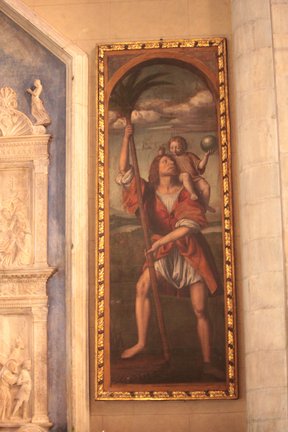Campata destra 2
Il secondo altare è detto di Santa Lucia perché vi si celebrava nella sua festa almeno dal 1627.
La cappella in origine era dedicata a San Lorenzo, raffigurato nella chiave di volta.
La pala d’altare è datata 1492 e mostra l’aggiornamento all’uso della prospettiva rinascimentale. È firmata da Tommaso Rodari, lo scultore che era anche, dal 1487, l’architetto della Fabbrica del Duomo. Il tema raffigurato nelle sei formelle è quello della Passione di Gesù che culmina in alto con la Crocifissione e si risolve oltre la cornice con il Cristo Risorto fra gli angeli.
I committenti furono il canonico Bartolomeo Parravicini, e suo nipote, l’avvocato Giacomo Parravicini, di nobile famiglia comasca. I due personaggi sono ritratti di profilo nei due tondi alla base, seguendo il modello umanistico che si rifà alle monete antiche.
Nella predella sono raffigurati da sinistra S. Antonio da Padova, S. Pietro, la Madonna col Bambino, S. Caterina d’Alessandria, S. Gregorio papa.
Ai lati dell’altare sono due grandi tele a tempera dipinte da Bernardino Luini che raffigurano san Sebastiano e San Cristoforo .
Sotto la mensa funge da paliotto un’opera a cinque formelle di Alberto da Campione realizzata a cavallo fra ‘300 e ‘400 .
La vetrata raffigura l’Annunciazione e lo Sposalizio della Vergine di Giuseppe Bertini (1857-58). Sulla cornice della finestra sono scolpite sei Virtù ).
L’arazzo appeso verso la navata centrale raffigura Abramo e Melchidesech opera del 1595 dell’arazziere mediceo Guasparri Papini di Firenze su disegno di Alessandro Allori per la Confraternita del Ss. Sacramento .
Al centro della volta è scolpito il santo titolare della cappella San Lorenzo
Il martire Lorenzo è raffigurato come giovane imberbe, mentre regge la palma del martirio e la graticola sulla quale fu bruciato. Veste la dalmatica da diacono color rosa. Il rilievo è di autori ignoti, scolpito e dipinto dopo il 1473, anno di fondazione della cappella.
La citata pala d’altare del 1492 scolpita da Tommaso Rodari fu voluta dal canonico Bartolomeo Parravicini, che nel 1462 era già “decretorum doctor” e vicario del vescovo. Oltre ai ritratti suo e del nipote è scolpito lo stemma della famiglia Parravicini alla sommità della pala di qua e di là nei due scudi dalla tipica sagoma rinascimentale a teschio di cavallo. Il cigno è emblema araldico dello stemma “parlante” per l’assonanza tra la parola cigni con il nome Parravicini. Tutta la pala è circondata da una cornice di marmo che reca cardini un tempo serviti a chiuderla con ante.
Nel polittico i sei episodi della Passione di Gesù sono ambientati in spazi prospettici, separati verticalmente da lesene a candelabra, orizzontalmente da trabeazioni classiche, concluse in alto da una cimasa a tre lunette, con motivi a conchiglia in quelle laterali e nella centrale il tema della Resurrezione (Cristo risorto e quattro angeli adoranti emergono dalle linee architettoniche). I soldati addormentati presso il sarcofago ma pronti al risveglio sono un tema antichissimo (l’Anastasis paleocristiana), tema recuperato qualche anno prima a Sansepolcro da Piero della Francesca. L’altissima croce, abbracciata dalla Maddalena fra Maria e Giovanni, nella formella centrale e più slanciata che si staglia su un paesaggio lontano, è tema di origine nordica, forse mediato da modelli pittorici veneti, così come il tema della Pietà nella versione di origini tedesche del Vesperbuild, con Maria che regge il corpo morto di Gesù sulle ginocchia, nella formella in alto a destra.
Il racconto si svolge a partire dal basso, propriamente dalla formella centrale con l’Incoronazione di spine, posta al centro per ribadire la regalità di Cristo, solennizzata dall’arco che si lega prospetticamente agli edifici delle due formelle laterali con la Flagellazione e la Salita al Calvario. L’episodio di Gesù che attende di essere crocifisso, mentre un aguzzino perfora la croce con un trapano, è quanto mai angosciante, ma non rientrerà fra le 14 stazioni della Via Crucis, allora non ancora elaborata dalla spiritualità dei frati francescani.






